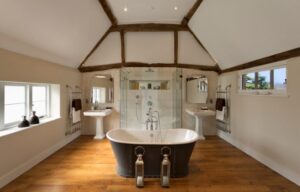Attached vs. Detached Family Homes: Which One’s Your Jam?
Hey there, home enthusiasts! Let’s settle the age-old debate: attached or detached homes? You know, the kind of question that splits dinner parties faster than someone saying pineapple belongs on pizza. (Spoiler: It does, but we’ll save that hot take for another day.) Whether you’re house-hunting, planning a custom remodel, or just daydreaming about your forever nest, we’re breaking down the pros, cons, and “oh, I didn’t think of that” moments. And hey, if you’re in Denver and need a hand, our crew at Verified Builders lives for this stuff. Let’s dive in!
Contents
- 1 The Basics: What’s the Difference?
- 2 Attached Homes: The Good, the Bad, and the “Hear-Through-Walls”
- 3 Why Attached Might Be Your Vibe
- 4 The “Uh-Oh” Moments
- 5 Detached Homes: Freedom, Space, and… Yard Work?
- 6 Why Detached Homes Rule
- 7 The “Think Twice” List
- 8 Cost Showdown: Which Saves You More Long-Term?
- 9 “But What About My Lifestyle?” Glad You Asked.
- 10 For Busy Bees & Minimalists
- 11 For Growing Families & DIY Warriors
- 12 When to Call a Pro (Like, Yesterday)
- 13 FAQs: Your Burning Questions, Answered
- 14 Final Thoughts: Ready to Make Moves?
The Basics: What’s the Difference?
First off, let’s get everyone on the same page. Attached homes share at least one wall with a neighbor—think townhouses, duplexes, or row homes. Detached homes? They’re the lone wolves, standing proudly on their own lot. Simple, right? But the devil’s in the details.
Why does this matter?
- Privacy: Detached homes mean no shared walls (translation: no surprise karaoke nights from next door).
- Cost: Attached homes often cost less upfront. Cha-ching!
- Maintenance: Less exterior space = fewer Saturday mornings spent mowing. Or more time for Netflix. Your call.
Attached Homes: The Good, the Bad, and the “Hear-Through-Walls”
Why Attached Might Be Your Vibe
- Lower upfront costs: Perfect if you’re budget-conscious but still want a slice of homeownership.
- Community vibes: Neighbors are right there. Great if you’re into block parties or borrowing sugar.
- Easier maintenance: Snowblowing a tiny driveway? Yes, please.
The “Uh-Oh” Moments
- Noise complaints: Ever heard a toddler’s 3 a.m. meltdown through drywall? Exactly.
- HOA drama: Some attached communities have strict rules. No neon pink front doors? Boring.
- Resale quirks: Your home’s value might hinge on the neighbor’s questionable lawn gnome collection.
FYI: If you’re eyeing an attached home but crave upgrades, Verified Builders specializes in basement remodels and bathroom renovations to maximize your space. Because let’s face it—nobody wants a 1990s powder room.
Detached Homes: Freedom, Space, and… Yard Work?
Why Detached Homes Rule
- Total privacy: Blast your questionable music (we won’t judge).
- Customization galore: Want a treehouse, chicken coop, or luxury home renovation? Go nuts.
- Resale value: Detached homes often appreciate faster. Cha-ching again!
The “Think Twice” List
- Higher costs: More space = more $$$. And don’t forget property taxes!
- Maintenance overload: Roofs, lawns, fences—oh my!
- Isolation: If you’re not into waving at neighbors from your porch, maybe it’s too quiet.
Pro Tip: If you’re drowning in yard work, our home addition contractors at Verified Builders can turn that overgrown shed into a chic office. Just saying.
Cost Showdown: Which Saves You More Long-Term?
Let’s get real—budget’s a biggie. Here’s a quick comparison table to break it down:
| Factor | Attached Home | Detached Home |
|---|---|---|
| Upfront Cost | Lower (shared walls = savings) | Higher (land + structure costs) |
| Utilities | Often cheaper (smaller space) | Higher (more square footage) |
| Maintenance | Minimal (shared exterior costs) | All on you, baby |
| Resale Value | Moderate (depends on community) | Typically higher |
IMO, detached homes win for long-term investment, but attached homes are killer for first-time buyers. Either way, a whole house remodeling project can boost your ROI. Hint, hint.
“But What About My Lifestyle?” Glad You Asked.
For Busy Bees & Minimalists
Attached homes are low-maintenance heaven. Less time fixing gutters = more time for hiking Rockies trails. Plus, if you’re into bathroom remodeling or basement contractors to add flair, we’ve got your back.
For Growing Families & DIY Warriors
Detached homes give room to sprawl. Add a playroom, pool, or home addition without negotiating with an HOA. Just keep a lawnmower handy—and maybe a therapist for when the sprinklers break.
When to Call a Pro (Like, Yesterday)
Look, we get it. YouTube tutorials make home renovation look easy. But unless you want your “DIY floating shelf” to become a ceiling cave-in, hire a general contractor. Here’s when to pick up the phone:
- Structural changes: Knocking down walls? Let’s not recreate Honey, I Shrunk the House.
- Permits & codes: Denver’s rules are trickier than assembling IKEA furniture.
- Luxury upgrades: Marble counters? Smart homes? Leave it to luxury home renovations experts.
Verified Builders isn’t just another remodeling company—we’re your hype crew. Check our reviews; we’ve turned “meh” spaces into “whoa” places for years.
FAQs: Your Burning Questions, Answered
1. “Is an attached home cheaper than a detached one?”
Usually, yes—upfront. But factor in HOA fees and potential custom remodels. Detached homes cost more initially but often pay off later.
2. “Can I make an attached home feel private?”
Absolutely! Soundproofing, tall fences, and strategic landscaping work wonders. Or just drown out noise with a white noise machine. Parenting hack unlocked.
3. “Which has better resale value?”
Detached, hands down. But a bathroom renovation contractor or basement remodel contractor can boost either home’s appeal.
Final Thoughts: Ready to Make Moves?
Whether you’re team attached or detached, there’s no “wrong” answer—just what fits your life right now. And hey, if you’re in Denver and need a home renovation contractor near me (see what we did there?), Verified Builders is here to turn your vision into reality. From whole house remodeling to adding that secret bookcase door you’ve always wanted (no judgment), we’re your go-to.
So, what’s next? Grab a coffee, stalk our reviews, and give us a shout. Let’s build something awesome together—without the karaoke-induced drywall trauma. 😉
Verified Builders // Denver’s Favorite Remodeling Company // Let’s Chat: 720-XXX-XXXX


